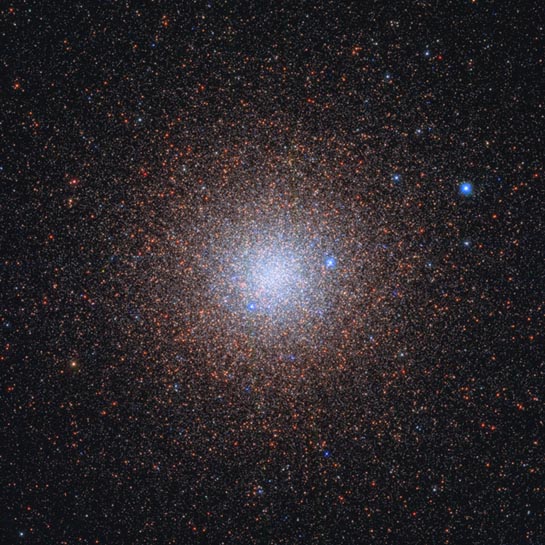
Globular Cluster
RA 17h 50m 13.16s Dec -37° 3' 5.11"
Scorpius
13,000 light years
7.2
9.6 arcmin
2.40 x 2.42 arcminutes
North is 32.6° left of vertical
ESA/Hubble & NASA, G. Piotto
June 1, 2020
ABOUT
THIS IMAGE:
Almost like snowflakes, the stars of the globular cluster NGC 6441 sparkle peacefully in the night sky, about 13,000 light-years from the Milky Way's galactic center. Like snowflakes, the exact number of stars in such a cluster is difficult to discern. It is estimated that together the stars weigh 1.6 million times the mass of the Sun, making NGC 6441 one of the most massive and luminous globular clusters in the Milky Way.
NGC 6441 is host to four pulsars that each complete a single rotation in a few milliseconds. Also hidden within this cluster is JaFu 2, a planetary nebula. Despite its name, this has little to do with planets. A phase in the evolution of intermediate-mass stars, planetary nebulae last for only a few tens of thousands of years, the blink of an eye on astronomical timescales.
There are about 150 known globular clusters in the Milky Way. Globular clusters contain some of the first stars to be produced in a galaxy, but the details of their origins and evolution still elude astronomers.
From Wikipedia:
NGC 6441 is a globular cluster in the southern constellation of Scorpius. It was discovered by the Scottish astronomer James Dunlop on May 13, 1826, who described it as "a small, well-defined rather bright nebula, about 20? in diameter". The cluster is located 5 arc minutes east-northeast of the star G Scorpii, and is some 44,000 light years from the Sun.
This is one of the most massive and luminous globular clusters in the Milky Way, with an estimated 1.6 million solar masses of stars. It is located in the bulge of the galaxy at a distance of 13 kilolight-years (3.9 kpc) from the core and is considered metal "rich". That is, it has a relatively high abundance of elements with higher mass than helium. The core region of the cluster subtends an angle of 0.11 arc minutes, compared to the half-mass radius of 0.64 arc minutes. The density of stars in the core region is indicated by the luminosity density: 5.25 L☉ pc-3. The cluster has a half-light radius of 7.1 ly (2.18 pc).
This cluster has an abnormally large number of RR Lyrae variables-68 candidates as of 2006, and their periods are longer than is typical for their respective metallicities. (The mean period for the cluster's RRab stars is 0.759 day.) There are also several type II Cepheid stars, which is unusual given the high metallicity of this cluster. Examination of the red giant branch section of the color-magnitude diagram suggests that there are at least two and possibly three distinct populations in the cluster. The brightest and higher temperature members of the red clump stars are more concentrated toward the center of the cluster. This group may be a helium-enriched second generation of stars.
The
cluster contains at least four millisecond pulsars, of which two are in
binary systems. One of these binaries, PSR J1750-37A, is in a highly eccentric
orbit with an eccentricity of 0.71. The cluster has an X-ray burster,
X1746-370, which has the longest period known in any globular cluster
and is consistent with the galaxy as a whole. Finally, there is a planetary
nebula, JaFu 2, one of only four planetary nebulas known to inhabit globular
clusters in the Milky Way.